You have an exam coming up that you need to study for. You grab your books, highlighters/pens, and lecture notes and buckle down for a late-night study session. You wake up the next morning feeling good, informed, and ready to conquer the exam.
But when your teacher sets it down in front of you, you don't see any of the information from your notes on the test and quickly realize everything you studied was either incomplete or irrelevant to what was in front of you.
All the confidence you came into class with has slowly depleted, and now you're facing the possibility of bombing your exam. If this scenario hits home, trust me when I say I've been there and done that, but I am here to show you a way it doesn't happen again.
Today's topic is all about how to properly take notes in college that will prevent you from feeling like your class notes failed you. I know firsthand what it's like to try and follow lecture notes that feel like information overload, leaving me to write down anything and nothing at the same time. Either I didn't know where to start or how to organize notes, or I simply didn't realize I wasn't taking down effective notes, and if I can help break this cycle, I will.
In this article, I will discuss the importance of note-taking, some note-taking methods, different note-taking formats, and the benefits of taking notes. I will also leave you with my favorite note-taking tips that helped me get through undergrad.
So, if you're a student who wants to write better notes, more detailed notes, or simply wants a better understanding of note-taking, you've come to the right place. Grab a pen and some paper, and let's get into it!
Kick-start the new school year off right by applying for scholarships today!

The Importance of Taking Notes
As a student, you've always been told taking notes in class is the key to academic success, but teachers don't always go into detail as to how or why it's important, leaving the note-taking process to drag. But luckily for you, I'm here to tell you why.
Taking notes is an important practice because it offers several benefits that can help you with the retention and comprehension of information. I've always struggled with comprehension, and when I started really honing in on forming my own note-taking method, I started engaging with the material, understanding it more and more, even by memory. Notes serve as key references, allowing you to easily remember important details in difficult subjects.
And though it may not seem like it, having good notes also helps you tap into your critical thinking and analytical skills. Notes is an act of processing and evaluating information in real-time, so even if you don't understand something immediately, jotting down supporting facts or key terms out of an entire lecture gives you the opportunity to go back for a second glance and really help the information sink in.
Taking notes aids in not only comprehension and critical thinking but personal growth as well. Note-taking is a versatile skill that enhances your learning experience and organization, ultimately preparing you for the future.
Get Matched to Thousands of Scholarships
Create your Bold.org profile to access thousands of exclusive scholarships, available only on Bold.org.
Create Free ProfileIn-class Benefits
So, we know how taking notes can help you on a personal level, but let's talk about some in-call benefits of note-taking, like promoting active engagement. No matter how hard you try to work around it, taking notes 100% requires you to actively listen and engage with the lecture.
I was always the student who paid attention selectively, losing out on important information, so note-taking helps you stay focused and attentive during class discussions, which will also help you understand the lecture even more.
Taking notes in class also helps keep your information organized, and having organizational skills is a major key to keeping good notes. It also helps you structure the information in your own way. For instance, summarizing key points, highlighting important details, or creating headings or subheadings all help create a visual representation of your study material, making it easier for you to comprehend and review later.
And lastly, having notes and key points helps with the identification of key concepts. If something isn't resonating at the time of the lecture, your notes will allow you to go back to identify and distinguish the importance of the material.
Knowing What to Write Down
Now, taking your own notes is important, yes, but without knowing what to write down, you could be setting yourself up for an incomplete study guide. So, when deciding what to write down, let's go over what to focus on. Here are some strategies that can help you figure out what to include:
- Listen actively: I know lectures can be boring, but paying close attention to the material does help you identify main points, important details, and any key examples or explanations.
- Prioritize key information: Instead of trying to write your notes quickly, focus on the most important sections, facts, and ideas.
- Use abbreviations and symbols: Believe it or not, abbreviations and symbols can help you take notes more efficiently and capture information quickly without sacrificing comprehension.
- Organize your notes: I cannot stress this enough, but organization is key. Use headings, bullet points, or numbering to structure your notes. This will visually separate different topics or subtopics, making it easier to review and understand later.
- Be selective with details: While it's important to include relevant details, you don't want to get caught up in writing down every single piece of information. Focus on the main concepts and supporting evidence.
- Ask questions! Don't be afraid to engage and ask questions at any time, especially if you're confused. This is your personalized study guide. Make sure to use your voice to help pinpoint any main ideas you need.
So, next time you're in class and need to take notes, think of what you need to know vs anything you can write quickly, and you'll set yourself up for success!
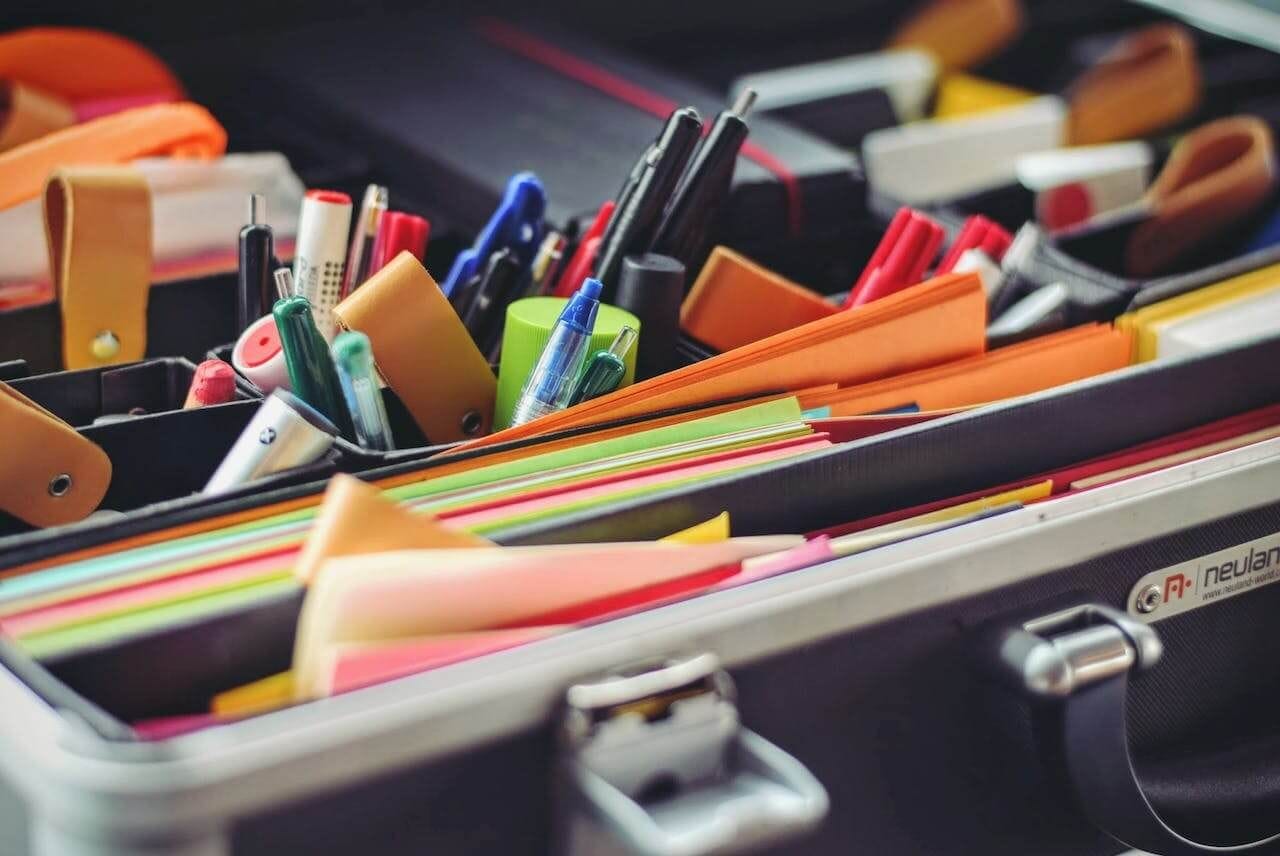
Different Note-Taking Methods for College Students
I'll be the first one to admit that it took me a few decades to realize I was taking down notes all wrong. And if you're like me, you also didn't know there are different note-taking methods for college students, all designed to emphasize the proper structure for quality note-taking. Let's go over a few of these methods.
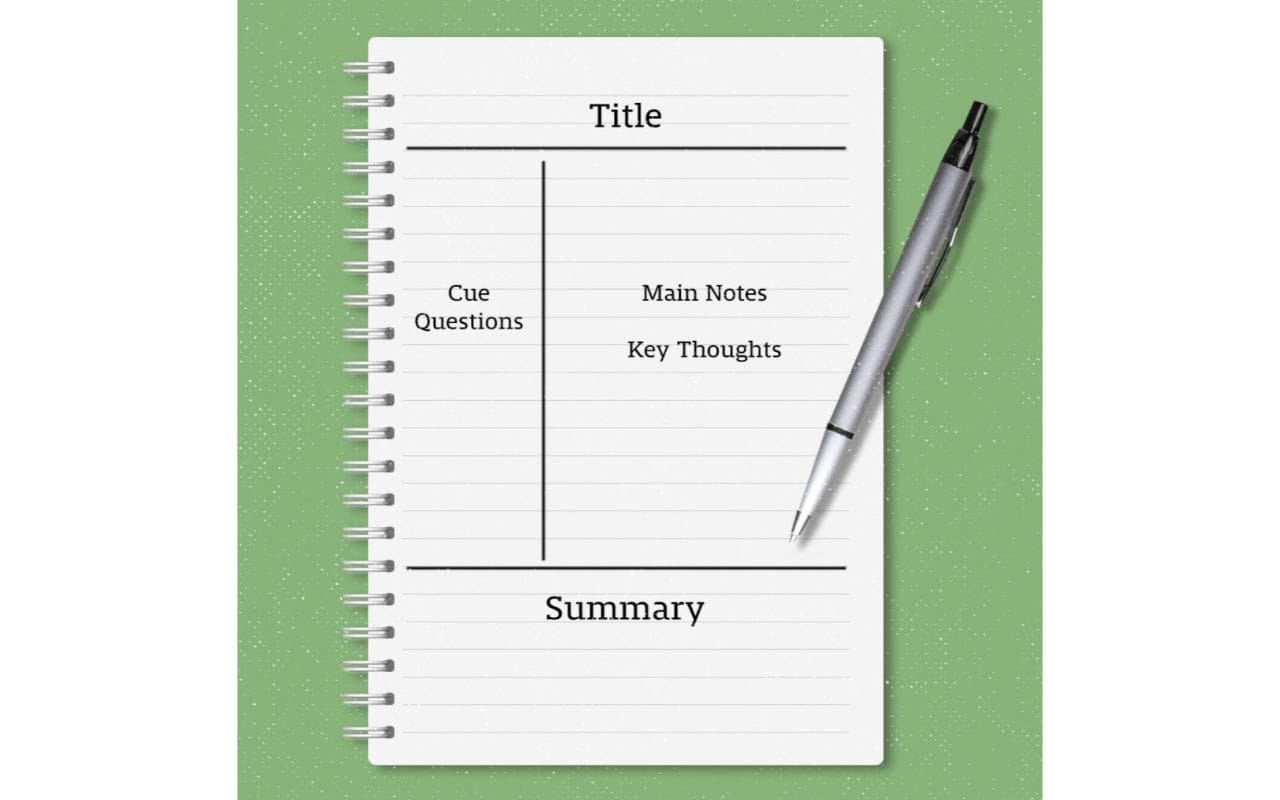
The Cornell Method
The Cornell Method is a note-taking system created by Walter Pauk at Cornell University. This method was designed to help students organize and review their notes effectively by dividing note paper into three sections: a narrow left-hand column, a wider right-hand column, and a bottom section.
In the lecture, the main ideas, keywords, and questions are written in the right-hand column. This section reserves space for gathering information. The left-hand column is used to write down specific cues or summaries related to the main ideas. These cues act as prompts to study later. The bottom section is reserved for summarizing the main points of the entire page.
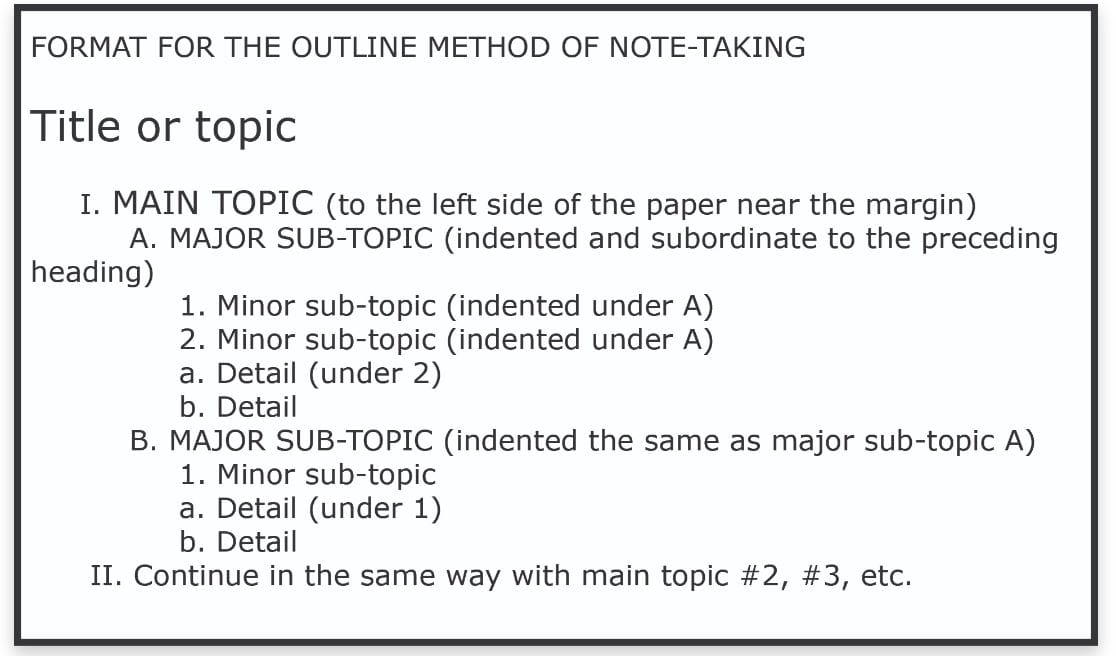
The Outline Method or Linear Method
The Outline Method is a note-taking technique that involves structuring information in a hierarchical format (or order of importance). Here's a breakdown of the steps:
- Heading
- Main points
- Subpoints
- More subpoints
- Formatting
- Summarize and condense
The Outline Method is a logical and organized structure, making it easier to review the material later. It helps you identify the main ideas and their relationships, helping with comprehension. By using headings and subheadings, the Outline Method builds a visual representation of the content order, making it easier to locate specific information within your notes.
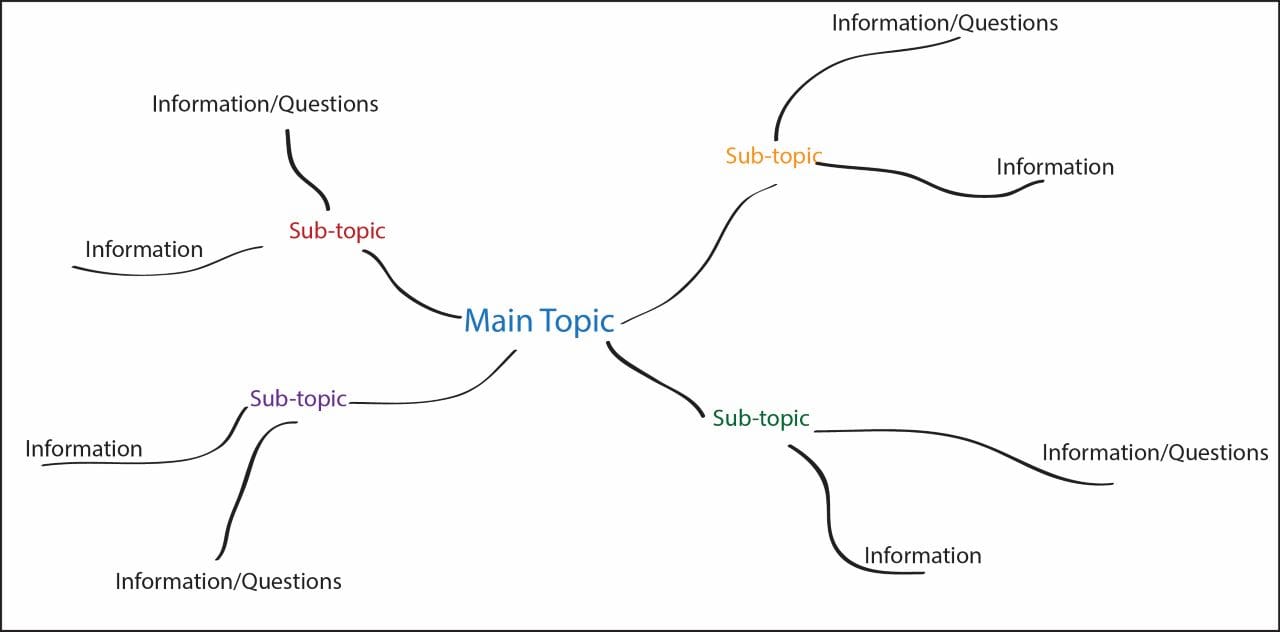
The Mapping Method
The mapping method, also known as “concept mapping,” provides a graphical representation of information, ideas, facts, and concepts. This format involves writing the main topic into the center of your paper, dry-erase board, etc., and connecting related subtopics, ideas, and concepts through branches, images, and colors, almost like a graph.
The mapping method is designed to maximize active participation in note-takers by requiring them to organize facts, ideas, and information in a logical map.
Remember, the goal of note-taking is to create a concise and organized summary of the information that is helpful to you. Experiment with these different techniques and find a method that works best for your learning style.
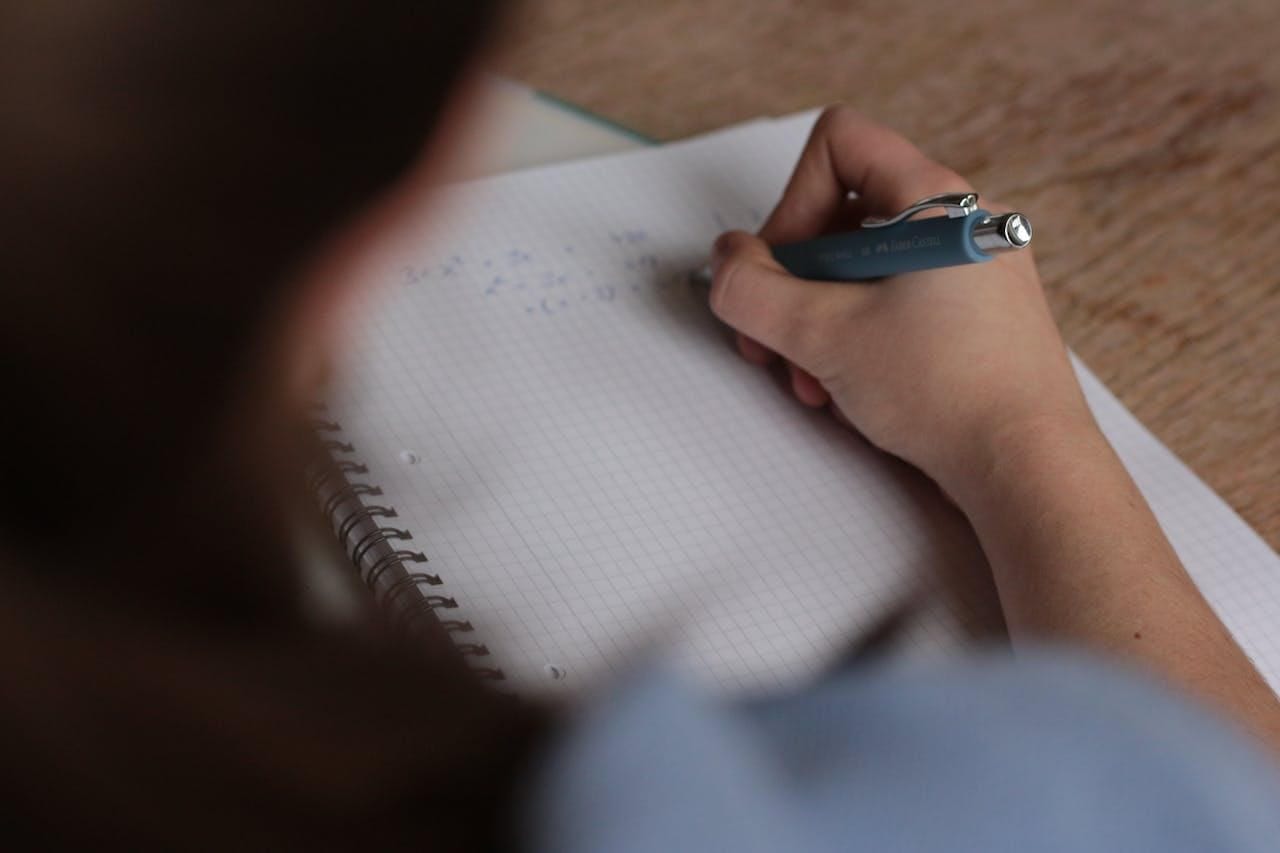
Different Formats for Note-Taking
With the rise of AI and technology boom over the last several years, people have slowly weened off pen and paper and adopted the iPad or preferred notes application for note-taking, and while there's nothing wrong with using technology advancements to take notes, I just want to remind you that there are pros and cons to everything.
Whether you prefer taking notes on your phone or the old-school way via pen and paper, let's go over the differences in both formats.
Digital Notes
Digital notes have their advantages when it comes to convenience, but are digital notes the new Roman empire for note-taking?
Pros:
- Accessibility
- Portability
- Organization
- Searchability
- Collaboration and sharing
- Multimedia integration
- Backup and synchronization
Cons:
- Distractions
- Technical issues
- Dependency
- Limited handwriting options
- Battery life
- Device limitations
- Security and privacy concerns
Handwritten Notes
If you ask me, there's nothing like the feel of a pen on paper, but like digital notes, handwritten notes have their pros and cons, too.
Pros:
- Enhanced memory
- Personalization
- Creativity
- Reduced distractions
- Improved focus
Cons
- Limited searchability
- Potential for illegibility
- Lack of backup
- Limited sharing
- Limited collaboration
Ultimately, the choice between digital and traditional handwritten notes depends entirely on your preferences. Some people may find a combination of both methods to be an effective approach to note-taking, and that's just fine as long as it works for you.
Top 10 Tips for Taking Notes
We've finally made it to the main event! You might want to get out a pen and paper or open up your notes app and get into my top 10 tips for taking notes. Let's go!
- Be prepared: First things first, you won't always want to make sure you head into a note-taking session prepared with the necessary materials like pens, paper, or a digital device.
- Stay organized: Again, organization is key! Use headings, bullet points, or numbering structure when writing or typing notes.
- Listen actively: I know lectures can be boring, but be sure to pay attention to your professor and focus on key points and concepts.
- Use abbreviations and symbols: Even though it sounds odd, it's a good idea to develop your own system of abbreviations and symbols you can go back to for memorization.
- Be selective: You want to try to avoid writing everything down. Instead, focus on the main points, examples, and important points.
- Review and revise: Reviewing and revising your notes will help your understanding and fill in any gaps in comprehension.
- Highlight important information: Use highlighting or underlining to emphasize key points or concepts that you want to remember. You can also get creative and color-coordinate your notes.
- Use visuals: Depending on the subject of your notes, using diagrams, charts, or mind maps to represent complex information can also help with understanding.
- Ask questions: One thing I wish I did more was ask questions. Don't be afraid to use your voice for clarification or seek additional information to ensure proper note-taking.
- Personalize your notes: Lastly, add your own thoughts, connections, and examples to make your notes more memorable.
Keep in mind that these are the tips that helped my note-taking and studying evolve, so feel free to use these steps and make them your own! Though following these tips will be effective, the goal is to find a method that works for you.

Benefits of Taking Notes
By now, you should know that taking notes offers several benefits that can help your learning methods and overall productivity in class. It motivates you to prepare well before you get to class so you head into any lecture ready and focused. But, in case you need some reiteration, here are some key benefits of note-taking:
- Improved information retention
- More in-class engagement
- Helps build organization skills and proper structure
- Keeps you focused and motivated
- A way to personalize your study material
- Provides a quick reference
- Encourages critical thinking and analysis
- Promotes collaboration and sharing with your peers
Overall, note-taking contributes to a more effective and efficient learning experience for students. Whether it be on Google Docs or bullet journaling, don't underestimate the importance of good note-taking. Just make sure your method works and leads you to academic success.
Ways Note-Taking Can Prepare You for the Future
So, is note-taking that serious? Of course, it is! When you're young and in college, you don't think of the value there is in taking good notes but trust me when I say there is. Though you may not be taking exams every quarter, taking notes is a skill you will use later in your future.
For instance, learning how to take good notes helps with organization, which will become helpful in the future. Let's say you have a big meeting coming up at work. Having your own note-taking system supports and helps keep your organizational habits in line by prioritizing important information.
They also serve as references, allowing you to remember details and concepts with key words easily. Well-organized notes can help you to quickly find relevant information, saving you time and effort in the future.
I know, I know, having a note-taking method sounds like a tedious and unnecessary skill to have outside of a college setting, but if I'd known then what I know now regarding knowing how to write notes, I would've paid more attention and trained myself how to be the note taker I am today.

Frequently Asked Questions About Note-Taking in College
What is the best method for taking notes in college?
Depending on the kind of learner you are, any of the three note-taking methods above can suit you and push you to be a master note-taker. For instance, if you're a visual learner, the mapping method might be for you, or if you're all about order of importance, the Cornell method would be a bit better. And if you're still unsure, experiment with these and even other note-taking styles until you find something that works best for you.
How important are notes in college?
Plainly put, it's extremely important. Not only do notes help you succeed in class and on exams, but they also help add to your personal growth. Taking notes starts with organization and branches out to other real-world aspects like structure, comprehension, retention, and other real-world factors outside of college. And even though note-taking can be a pain, having a guide personalized to your learning methods will certainly lead you through doors to success.
Is it better to type or take notes by hand?
The format in which you choose to use for note-taking is completely up to you and what you prefer! Whether it be the clicks of a keyboard that motivate your note-taking or the feel of a brand new pen and notebook, taking notes by hand or digitally both have their pros and cons.
Some might even agree that both formats work just as well, equally. What's important is that you are comfortable with your preferred format for taking notes and that it works best for you.
Note-taking in college is only a small piece of the educational journey. If you have any questions regarding all things college, head over to Bold.org to create your free profile. We also offer great scholarships that can help cover education costs. But don't wait. Apply today!

About Chanelle
Chanelle is a dedicated and seasoned writer, editor, and researcher. She’s familiar with college admissions, finding and applying for scholarships, and the financial aid process.
She graduated from the University of South Florida with a major in English, Creative Writing with a specialization in Technical Writing.
Experience
Chanelle has over a decade of experience in the writing industry, specializing in blog writing, SEO writing, editing, translations, corporate writing, and various forms of creative writing. She founded and operated Femme Feature Magazine, an online and print publication dedicated to celebrating women in all corners of the creative field. An avid reader, Chanelle is constantly seeking refined and innovative ways to tell her stories. Writing is her foremost passion, and she is always on the lookout for her next narrative adventure.
Since joining the Bold.org team in 2023, Chanelle has brought her enthusiasm for merging the writing and digital worlds. She is dedicated to assisting students and young adults in navigating their educational and professional journeys.
Chanelle's unwavering commitment to her craft and her dedication to helping others shine through in her work. Leveraging her personal and professional experiences, she provides invaluable support to students, empowering them to achieve their goals and realize their potential.
Quote from Chanelle
“There is always a way to say the same thing over and over again. You just have to be creative and think outside the box.”